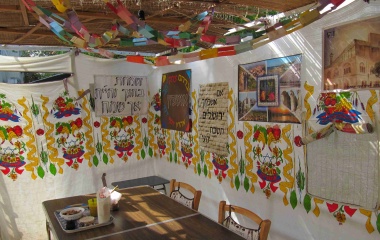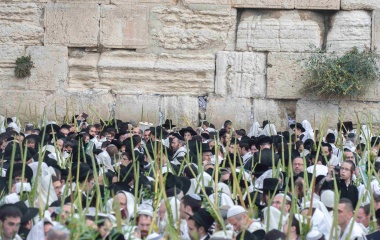
“Whoever did not see the celebration of the drawing of the water (simchat beit hashoeva) has never witnessed joy in their life” (Sukkah 51a). The Mishnah goes on to describe the dancing, the juggling, the music, and more of these most festive days. In an astonishing display of dexterity, the Gemara records how Rabban Shimon ben Gamliel would juggle eight torches of fire, “and they did not touch one another, and there was no living being who could do this” (ibid 53a). The “parties” went on through the night, so “that we did not see sleep on our eyes” (ibid).
Times of joy are wonderful—yet potentially dangerous. With the mood relaxed, the atmosphere festive, it is an easy step to letting our guard down. It should be no surprise that, in the midst of the description of the simchat beit hashoeva, the Gemara has a discussion relating to the power of the yetzer hara, the evil inclination.
In a most insightful comment, Rav Yehuda teaches that, “In the future, G-d will bring the yetzer hara and slaughter it before the righteous and before the wicked. To the righteous, it will have the appearance of a towering hill; and to the wicked, it will have the appearance of a strand of hair. Both the former and the latter will weep; the righteous will weep, saying, ‘How were we able to overcome such a towering hill?’ The wicked also will weep, saying, ‘How is it that we were unable to conquer this strand of hair?’ And the Holy One, blessed be He, will also marvel together with them” (ibid 52a).
We are faced with challenges to our moral fibre every day—“Rav Yitzchak said: every day, the [evil] inclination of a person grows stronger and stronger”. Some manage to overcome the evil inclination. There may be struggle and uncertainty as one battles to overcome the desires of the heart. Sinning really can be fun and offer much benefit in the short term (which can last a long time). Yet the righteous manage to overcome the yetzer hara, focusing on what is right, not what is convenient. Years later, they look back and realize that one slip here or there and they may have fallen off the cliff—and they cry, trembling, about what may have been, and cry with joy for what was.
Tragically, the reverse process happens with the wicked. They are unable to overcome their desires, succumbing to the temptations surrounding them. And the more accustomed to sin they become, the more their values invert. “Rav Huna said: When a person sins and repeats, it becomes to him as if it is allowed” (Sotah 22a). It is much easier to remake the sin than to remake the sinner. If they are “lucky” then at some point, long after the temporal pleasures of sin have passed, when they come face to face with the moral impact of their choices, they, too, will cry; a cry of sadness for what could have been—yet wasn’t.
Ironically, the Gemara’s next teaching is how difficult it is to escape the yetzer hara, which “at first appears like the thread of a spider, but ultimately becomes like cart ropes”. The yetzer hara is easy to defeat—initially. But we are, for better or worse, creatures of habit, and once accustomed to act in a certain way, it can take heroic efforts to change; in the words of our sages, aveira gorreret aveira, one sin begets another (Avot 4:2). But it can be done—good can defeat evil. And it can start with one mitzvah, as mitzvah gorerret mitzvah, one mitzvah begets another (ibid).
“The school of Rabbi Yishmael taught, if this revolting one [evil inclination] comes upon you, drag him to the Beit Hamidrash, the house of study. If he is of stone, he will dissolve; if of iron, he will shiver into fragments” (ibid 52b). The yetzer hara uses varying—and at times, opposing—approaches to entice man to sin. At times, it argues that Torah like a stone is cold and dry, inflexible and unyielding. Torah, the yetzer hara argues, is boring. Other times, it acts like metal, easily manipulated into various shapes and sizes. The fire of Torah burns within, but the excitement to embrace Torah may, like as it did with Nadav and Avihu, lead to foreign fires.
We must drag the yetzer hara to the Beit Midrash. Let it see the excitement that comes with proper study of Torah, and let it learn how Torah is applied to the “real “ world. While study is the first step, it is not enough—“study leads to action” (Kiddushin 40b). It is the observance of mitzvoth and the embracing of the values that underlie the mitzvoth that are the strongest weapon against the yetzer hara. And, if we can neutralize the yetzer hara, we can truly rejoice on Sukkot and throughout the year.



